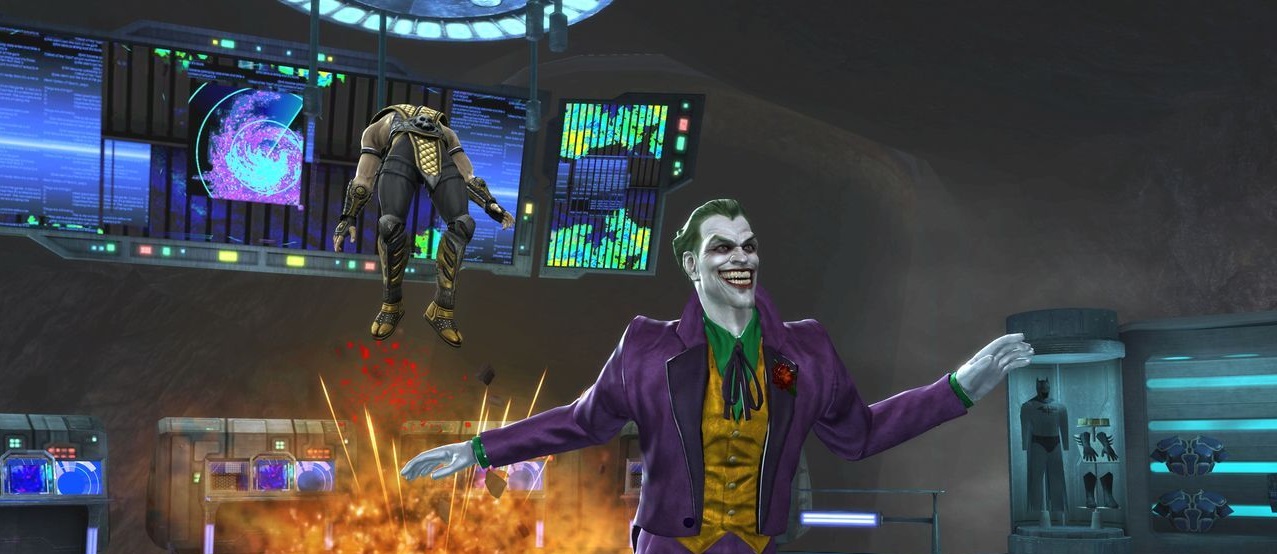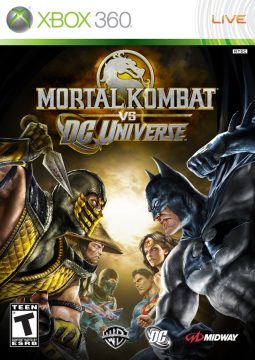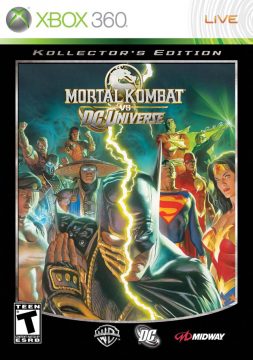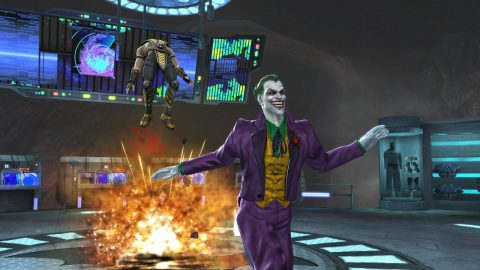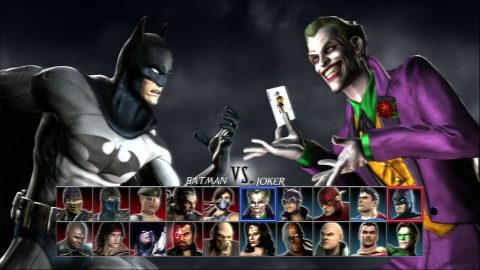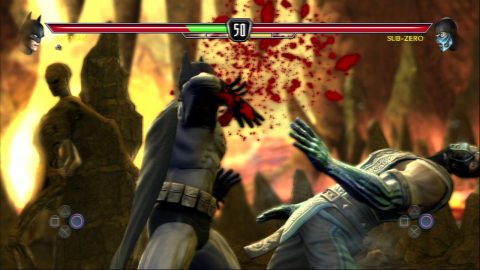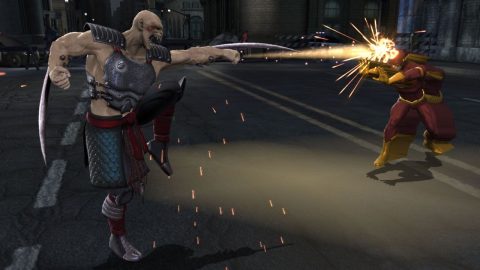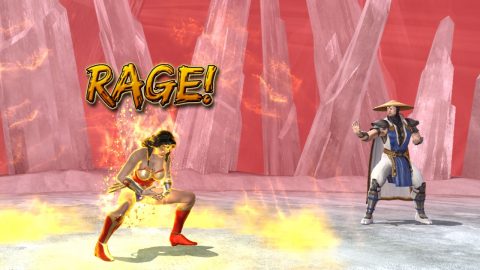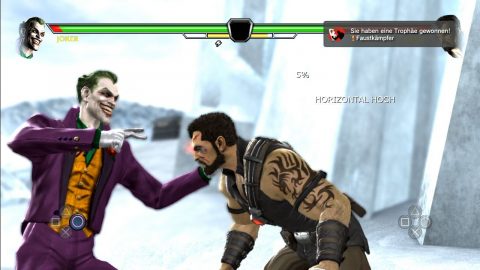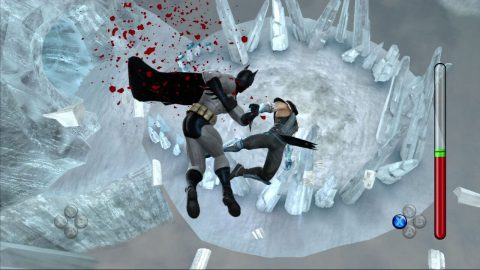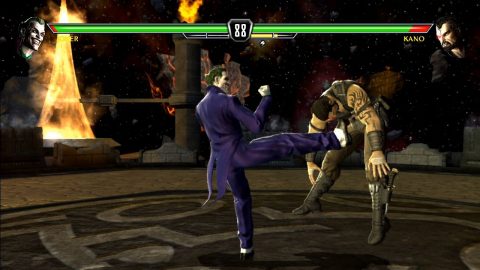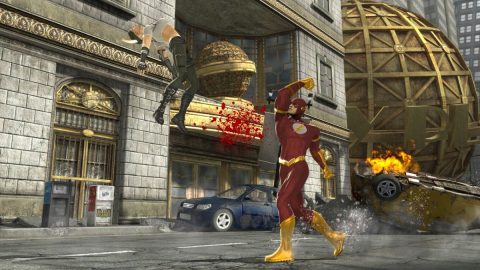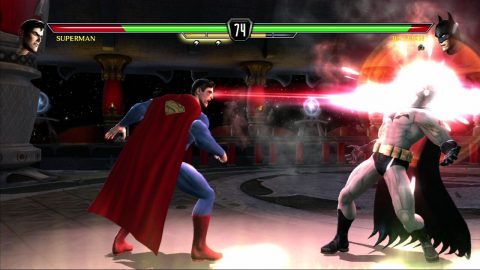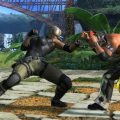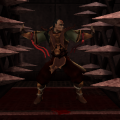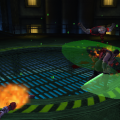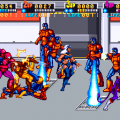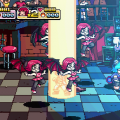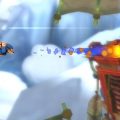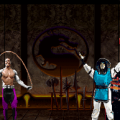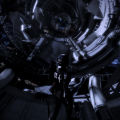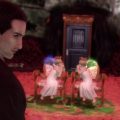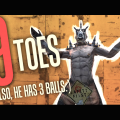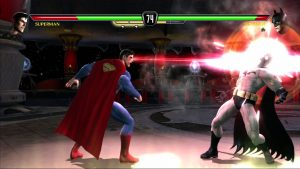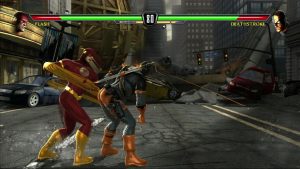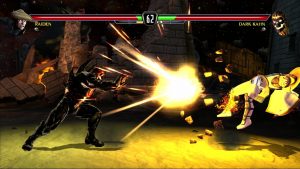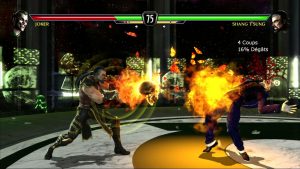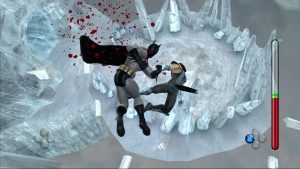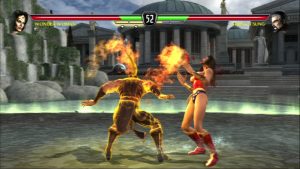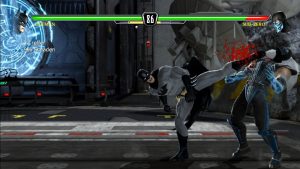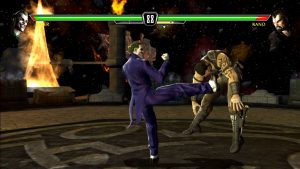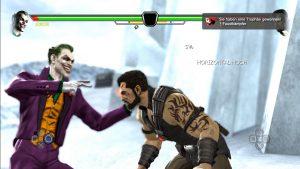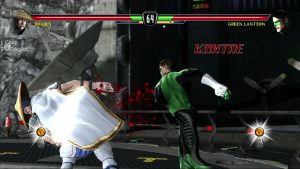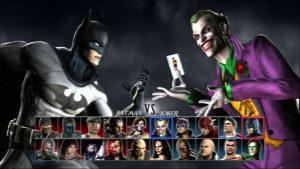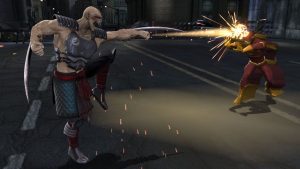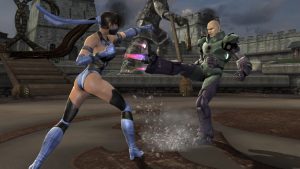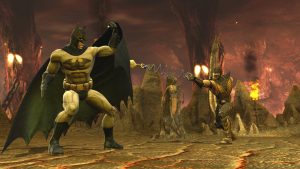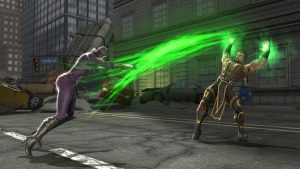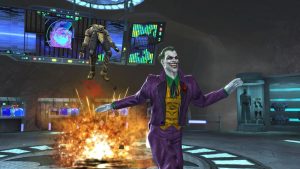- Mortal Kombat (Introduction)
- Mortal Kombat (1992)
- Mortal Kombat II
- Mortal Kombat 3
- Ultimate Mortal Kombat 3
- Mortal Kombat Trilogy
- Mortal Kombat 4
- Mortal Kombat Mythologies: Sub-Zero
- Mortal Kombat: Special Forces
- Mortal Kombat: Deadly Alliance
- Mortal Kombat Deception
- Mortal Kombat: Shaolin Monks
- Mortal Kombat Armageddon
- Mortal Kombat VS DC Universe
- Mortal Kombat (2011)
- Mortal Kombat X
- Mortal Kombat (Miscellaneous)
As one generation of consoles faded into the next, there were rumors and ideas being thrown around about what the next Mortal Kombat would be like. One idea apparently was to have an entirely new cast of characters except for Scorpion and Sub-Zero, while another was to base the look of the game off of Gears of War. As Midway slid further and further into bankruptcy, they decided to take a different track: It would be a crossover with the DC Universe. The hardcore fans were outraged by the defilement of their canon, while the non-fans just scoffed at what a stupid idea it was. And if that weren’t enough, due to restrictions placed on Midway by DC, the game would be shipped with a T rating. Needless to say, the fans were not happy. And so, under a storm of rage from fans and a deep indifference from everyone else, the game was released. How did it work out? Well, Virtua Fighter still doesn’t have much to worry about, but it generally does play a lot better than Armageddon did.
It should be noted that this actually isn’t the first attempt at a DC fighting game. Fans of forgotten fighting games may recall Justice League Task Force, released in 1995 for the Sega Genesis and Super Nintendo. It was pretty much forgotten as soon as it came out, likely because it was a subpar Street Fighter 2 clone that didn’t use its licenses as well as it could have. Its small roster didn’t help, either, nor did its lame choices for villians like Cheetah and Despero. It also had some real balance issues, especially whenever Superman was involved. (Who would have thunk, right?)
For this game, there’s actually a bit more of a focus on the story than the last handful of games, where they’d give you an intro cinematic, some brief endings, and a mostly unrelated Konquest mode. Instead of a Konquest mode, there’s now a new Story mode, where you’re asked to choose between the MK side or the DC side. While this doesn’t affect the plot at all, it will determine which characters you’ll be using and which side of the story you’ll see first. The story itself is delivered by cutscenes rendered in game, broken up every so often by fights. If you win the fight, you get to see more of the story, and if you don’t, you’ll need to restart the fight and try it again. If you put all the cutscenes together, removing the fights between them, you end up with about two hours worth of footage, which is pretty meaty for a fighting game.
The story is a ‘what if’ scenario that takes place shortly after Mortal Kombat 3. After a long battle between Darkseid and Superman, Darkseid attempts to escape into a portal. Superman uses his heat vision on the portal before he can escape, causing it to explode on Darkseid. Meanwhile, in the MK universe, Raiden uses his lightning to implode another portal on Shao Kahn. In a convenient coincidence, these events happen at exactly the same time, causing the two dimensions to merge together. This merging also inflicts all the characters with a thing called “the rage,” which causes them to go into a berserker frenzy. This is apparently the explanation for how The Joker, who has no real powers beyond being crazy, can get into a fight with Superman and win. MK characters meet up with DC’s, and they fight a lot before eventually joining together to kombat the true threat. Still more of a plot than Capcom gave their VS games, at least.
So you definitely shouldn’t be expecting anything on the level of Watchmen, The story’s biggest issue is that it really takes itself far too seriously. Sure, it’s Mortal Kombat, which automatically implies it’s not going to be all that bright and cheery, but when you’ve got DC superheroes getting involved, the mood tends to clash. There are a few funny moments, though, like how Joker reacts to hearing the name “Dark Kahn”, along with a scene where Batman wheels an unconscious Liu Kang around in an office chair. Sadly, they didn’t actually get anybody from the DC Animated Universe to provide voices, so everybody sounds a little off. Richard Epcar, who also voices Raiden, does the best Mark Hamill impression he can for The Joker. He’s not bad at it, but he doesn’t quite make it, either.
There are 23 characters in total, including Dark Kahn, the unplayable final boss. Both the MK and DC sides get 11 of their A-list characters making up their sides, with the MK side keeping their cast to the first couple of games. The other eleven characters make up the DC side, who mostly consist of the most popular DC characters that most people can think of. Aside from Deathstroke, who hadn’t really made many appearances outside the comics aside from the animated Teen Titans TV show. Which was more or less an entirely different character in the first place.
Having an entire set of new characters means that the DC characters are interesting to try out, even if they don’t feel that much different in gameplay than their MK counterparts. You’ve got Lex Luthor in a robot suit, for one thing, but aside from his special moves, he just does normal punches and kicks just like the rest of the fighters. Out of all the characters, The Joker feels like he’s had the most effort put into him. He gets more special moves than anybody else, more unique animations, and generally more polish than even his arch-nemesis Batman. Some effort went into making the characters’ basic moves feel a little more unique, with Sub-Zero being able to do a frozen punch and Catwoman using her claws. It’s not a lot of effort, but even the smallest amount helps the game rise above how identical everybody was in Armageddon.
The engine’s received a much needed overhaul since the last generation, and the game feels a little less clunky than any of the games from the previous generation. It still all takes place on a 3D field, meaning that you’re still free to sidestep around around the arena as much as you want. The characters no longer have multiple fighting styles, except for Baraka and Deathstroke, who trade one of their attack buttons for the ability to unsheathe their blades. The whole ‘fighting style’ gimmick never really worked out in practice, anyway, so its removal helps the game play a little more smoothly. The one thing that hasn’t been improved are throws, which are handled a little oddly in this game. Every character shares the same basic throw where they grab the opponent and throw them in whatever direction you hold, which doesn’t even do that much damage. The weird thing is that practically all the characters have a command grab in their special moves, so why couldn’t they just have used that?
Every character still has a list of chain combos, although they’ve all been shortened down to two or three hits now. It also takes less time to ‘recover’ from moves, which means you’ve got more freedom with your combos. With the way you can mix special moves into your combos, it’s sort of like a more modern version of MK2‘s combos, and you can find lots of ways to keep your opponent airborne. While the air combos from Armageddon are gone, the attacks you can perform from a prone position are still in, and they’re still reasonably useful for getting a few sneaky hits on your opponent.
There’s also a new rage meter, which builds up by hitting a blocking opponent and taking damage. Using half the meter lets you perform a combo breaker, replacing Armageddon‘s method of only three uses per match, ever. Filling the meter entirely and hitting both triggers activates Rage Mode, which results in a temporary boost in damage and defense. It also gives your character super armor and makes combos of a certain length unblockable. This generally means it’s not even worth fighting anybody using Rage, so the smart thing to do when this happens is try to keep away until it wears off. You can also perform a variant on special moves called Pro Moves. You do these by hitting the opponent with certain special moves and immediately following with either the same move or another one. If you pull these off correctly, both moves come out right after each other. But the timing is really strict on these, so pulling them off is harder than it sounds.
Replacing the old gimmicks and features of the last generation are a few ‘minigames’ that take place throughout the fight. The first of these is Klose Kombat, which is almost useless in actual practice. Hitting a specific button makes your fighter try to grab his opponent to pull him in closer. If it connects, the camera zooms in on the two fighters. The attacker can hit different buttons to perform close-ranged strikes on the defender. If the defender can hit the same button as the attacker, though, they’ll counterattack, ending the Klose Kombat until somebody starts another one. The problem with this mode is that it barely does any damage compared to just actually playing the game normally, and it takes so long to play out that it basically brings the fight to a complete halt.
The next gimmick is Freefall Kombat, which is a little easier to use than Klose Kombat, even if it’s not very intuitive itself. This mode is activated by knocking an opponent through certain stage boundaries, like in the games from the previous generation. Once you do this, the attacker leaps after the opponent. From Freefall Kombat, you can hit different buttons to pummel your opponents mid-air, but they can counter by hitting the same button and put you in the defensive position. Every hit from the attacker fills up a meter, and the higher the meter is, the more damage the fighter on the defensive will take when they hit the ground. Filling up the meter halfway will let the attacker use a super attack, which is a character-specific move that’ll add a little extra damage and have them automatically ‘win’ the Freefall Kombat. These supers, towards which most of the animation budget probably went, involve things like The Joker using an extendable boxing glove on his opponent, or Batman throwing an exploding Batarang. That’s right, the first time we get supers in a Mortal Kombat game and they’re being used in a silly mini game. That’s Midway for you, eh? Freefall Kombat, while not quite as utterly worthless as Klose Kombat, still feels pretty random about who will end up winning it or not, so it’s not really something you can rely on.
The final gimmick is a variation on Test Your Might, done by knocking your opponent through certain boundaries. When you do this, your character grabs the other fighter and starts running straight forward, smashing their way through whatever walls they come across. The attacker can mash the buttons to add extra damage, while the defender has to mash the buttons to try to keep some of the damage off of them. Out of all the new gimmicks, this one is the easiest to learn and one of the most fun, which logically means it’s the one you’ll probably see the least. While the stage transitions are still in, ring-outs and weapons are not, which means you can’t knock Superman into a meat grinder for him to magically reappear in Round 2.
The whole thing does feel less clunky than Armageddon and Deception, but only a little. All the new gimmicks tend to get in the way of the actual fighting. While the fighting mechanics have been improved a lot, it still feels like an MKgame. Which wouldn’t be an issue, except that the MK mechanics don’t fit quite right with DC superheroes. Compare Street Fighter to Capcom’s Marvel series, for example, where they added in huge energy beams, air combos, and all sorts of craziness to the fights. This game, on the other hand, feels kind of grounded, so the only things that really make the superheroes feel ‘super’ are their special moves. It doesn’t help that a lot of the animation still tends to be shared from character to character, so it feels kind of weird when you see Superman using the same Klose Kombat moves as The Joker.
Besides the story mode, you’ve still got the standard arcade mode, which gives you the choice to fight just the MKcharacters, just the DC characters, or both. Before you fight Dark Kahn, the final boss, you have to go up against either Shao Kahn or Darkseid. It wouldn’t really be accurate to call them subbosses, since they’re basically regular characters who happen to be the main villain and unlockable. They aren’t really all that much more powerful than anybody else, which means that they aren’t that difficult to fight. Dark Kahn’s a little more unique, even though he looks more like a lava monster than either of the two villians he supposed to be a combination of. He’s actually a little easier than Onaga or Moloch, since he doesn’t tend to no-sell your combos as much as they did. It might take you a continue or two to get to the point where he’ll inexplicably inflate and explode into lava chunks, but he’s a reasonable challenge. The endings are just a single still image with some narrations, but there are a few interesting ones in the bunch, like the one where Sub-Zero becomes Batman.
The final single player mode is Kombo Khallenge, where you’re given a set of ten combo trials for each character. You could try using what you learn in the actual game itself, but since you don’t actually unlock anything besides achievements for finishing this mode, it’s a distraction at best. There’s also online play, but with the much better reboot now out, good luck actually finding anybody to play with. Compared to the other games in the series, there’s actually not that much replay value at all once you clear the story mode. There’s only a couple of characters to unlock and no new arenas, costumes, or any sort of Krypt to buy things in.
And then we get to the Fatalities, which depending on just how much you love the gore, may or may not be a step back from the generic Fatalities of Armageddon. The game is rated T, which means that while there’s still blood, it’s only tiny spurts that don’t even hit the ground. The Mortal Kombat characters and the DC villians can still do Fatalities, and these vary in quality. Liu Kang gets a callback to Mortal Kombat 3, where he drops a Mortal Kombat 1 cabinet onto his defeated foe. Kano, however, has a Fatality where he leaps up into the air and stomps onto the opponent’s chest. Looks uncomfortable, sure, but if you look closely, you’ll notice the opponent is still breathing. That’s right, it’s a Fatality that isn’t actually fatal. Nintendo would be so proud.
The DC heroes, on the other hand, apparently don’t kill people, disregarding the fact that a lot of them actually kill quite a lot of people in their own comics. So they get ‘Heroic Brutalities’ instead, which serve the same purpose, but don’t actually kill the opponent, as shown by the beaten foe still wiggling around after it’s finished. Most of these are kind of OK, like the one where Superman uses his ice breath to freeze the opponent, flies into the air with them, and slams them into the ground. Which leaves them completely intact, for some reason, even though Sub-Zero does the same thing for one of his Fatalities. Also, Green Lantern uses his ring to case the opponent in a sphere, which he encloses around them with a crunch. The opponent falls out and drops to the floor, where they… don’t move at all. Something’s not right here.
There’s an interesting curiosity about one of Joker’s Fatalities, which is actually censored in the US version of the game. He basically takes a gun and shoots the opponent in the face. Before he actually fires, though, the screen zooms in on him so you can’t see the opponent actually getting shot. Yet one of his special moves also involves him shooting his opponent in the face, which the game has no problem showing. The PAL version of the game, however, doesn’t zoom out, and as it turns out, all that really happens is that the opponent falls over, much like they would if you used Joker’s gunshot in regular kombat. There’s also no issue with Jax throwing his opponent into the air and unloading a machine gun into them. Censorship standards are strange, strange things sometimes.
Something about the game looks really dark and washed out, and comparing it to how vibrant Street Fighter 4 looks, it makes MK vs DCU look kind of dingy. The colors have a very washed out look to them, and although it’s a look that fits decently with Mortal Kombat, it looks a little strange on a bunch of colorful superheroes. The DC characters look close enough to their appearance in the comics, at least. The music isn’t really noteworthy, and what you can actually hear over the fighting noises sounds like it came from your average superhero film. As a nice touch, the music subtly changes depending on what’s going on in the fight, like when Klose Kombat is initiated, but given how low-key the soundtrack is, you probably won’t even notice it over the sound effects.
The PS3 and Xbox 360 versions of the game are nearly identical, so whichever version you go for is a matter of personal preference. You would have to be either a hardcore MK or DC fan to pick this game up, though. The improvements to the engine are a big help, and they do genuinely make the game feel more fun to play. The problem is that the new gimmicks don’t really work too well, there’s not much in terms of extra content, and the superheroes just really don’t feel all that super. The game after this one would end up utterly wrecking this one, so grab that unless you really have to see Batman fighting Scorpion.
